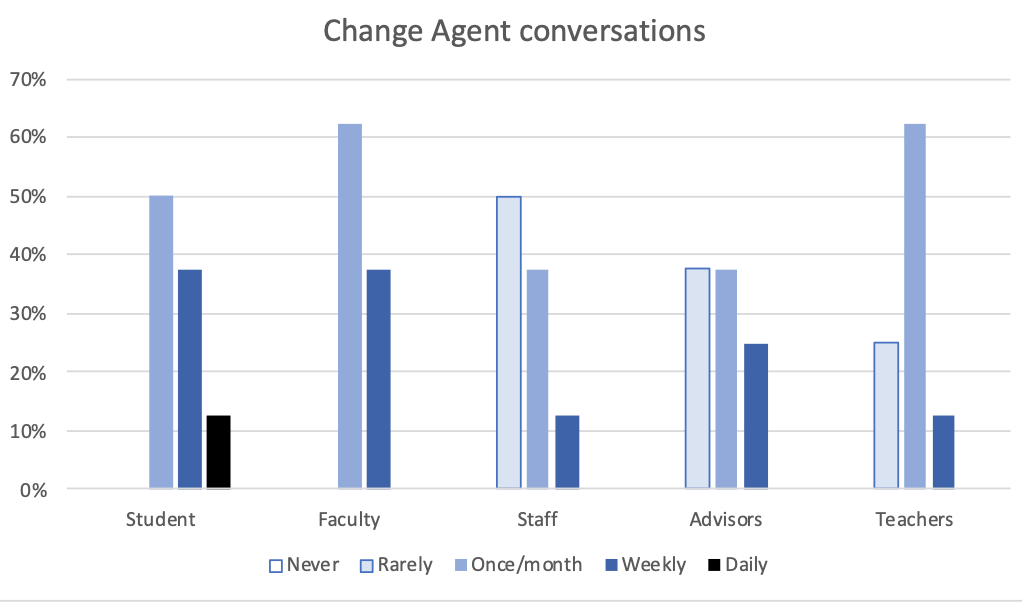What are Get the Facts Out Change Agents doing?
by Stephanie Chasteen
Get the Facts Out offers a wealth of resources for faculty working to promote teaching as a profession. But did you know that there is also a set of dedicated individuals who are tasked with spreading the messages of Get the Facts Out (GFO) across the nation? These 14 “Change Agents” in Math, Chemistry and Physics (listed here) are helping the project to conduct national campaigns to get the word out about the project and its resources.
I’m the GFO external evaluator, and so one of the questions that I wanted to answer was “What are the Change Agents doing?” This blog post will share that information to help share some of their strategies, and celebrate their influence! This data is based on the “Faculty Strategy Implementation” survey given to Change Agents in Summer 2020; this survey is at the end of the PTaP.HE survey about teaching professions given to all GFO study sites.
Change Agents seek to share information about the teaching profession
Change Agents typically have conversations with students on a monthly or weekly basis about the teaching profession, but they also talk with faculty and K12 teachers fairly regularly. Change Agents also typically actively seek out opportunities to share information about teaching as a profession on at least a monthly basis — and sometimes weekly. Can you say the same about your local work? If not, how might you seek out such opportunities?

Change Agents are reaching students in many ways
Most Change Agents are reaching large numbers of students (half of Change Agents indicated that they had reached more than 100 students); I estimate over 1,500 students have been reached by the project Change Agents and staff this past year (and an additional 1,000 by “champion” faculty), and 1,000 students the year before. They reached students through visiting classrooms, advisory meetings, visiting student clubs, giving presentations, using brochures and flyers, and posting GFO messages on listservs and Facebook.
See the GFO Reaching Students page for ideas.

Change Agents are also reaching faculty, staff, and advisors
Students aren’t the only ones who need to hear the GFO messages and Change Agents know this. Most also have conversations about teaching with faculty, staff, and advisors, collectively reaching over 1,500 of these individuals in each of the last two years through meetings, presentations at their institution or conferences, sharing the website, and other means. Did you know “Teaching: The Best Kept Secret!” is a faculty-oriented presentation for Get the Facts Out? Because faculty perceptions tend to be more stubborn to change, it does require a little more time but is an important piece of changing teaching perceptions. All Change Agents reported having used this particular presentation with faculty at least once. See the presentation for faculty, and also the tested messaging for faculty sections of the GFO site.
Most Change Agents use the materials with fidelity
I wrote previously about the importance of using GFO materials with “fidelity,” so that the approach aligns with the research. I have developed a scale to identify the degree to which people use GFO materials with fidelity (e.g. did they use the tested messaging from GFO, or avoid voicing misperceptions about the profession). Change Agents reported very high fidelity along these dimensions, with an average of 3.6 on a 4-point scale — they were particularly likely to emphasize the key message of GFO (that teachers rate their lives better than all other occupational groups, trailing only physicians), and to have compared teaching as a profession to academic careers in a positive light. There is an example of a Fidelity of Implementation Checklist in the instructions for the GFO student presentation.
Giving a GFO presentation is not without its challenges
Even Change Agents report that it takes some work to familiarize themselves with the materials and presentation. “It is always hard to give someone else’s presentation,” said one. “Sort of like giving a speech that someone else wrote. It takes a decent amount of effort.” Most said that they had modified the presentations slightly, tweaking them to make them relevant to the audience or to add local data.
Change Agents reported very positively on their engagement with the project; all of them indicated that they had been inspired to examine their own assumptions or perceptions of grade 7-12 teaching as a career, and that they have thought much more deliberately about sharing information about teaching in informal collaborations. “It did get me to think very deliberately about trying to change faculty misperceptions,” explained one, with another indicating that they are much more aware of how they talk about teaching careers with others.
How has GFO influenced you? Please share your ideas in the comments!




